
Rewilding Adirondack Waters
John Davis - Adirondack Council Rewilding Advocate
Thursday, August 17, 2023
Esteemed biologist Jerry Jenkins wryly noted in his Adirondack Atlas that the Forever Wild protection of Adirondack Park often seems to stop at the waterline. New York has done a remarkably good job of saving forest lands in its great Adirondack and Catskill Parks, but the same level of conservation has generally not been afforded waterways except those within designated Wilderness.
Northern New York streams are truncated by hundreds of man-made dams, many of them no longer serving useful purposes. As well, New York’s waters have been compromised by scores of non-native species – some of them purposely introduced. Conservation groups have advocated Quiet Waters; yet very few large lakes or rivers in Adirondack Park – and even fewer outside the Park – are kept motor-free.
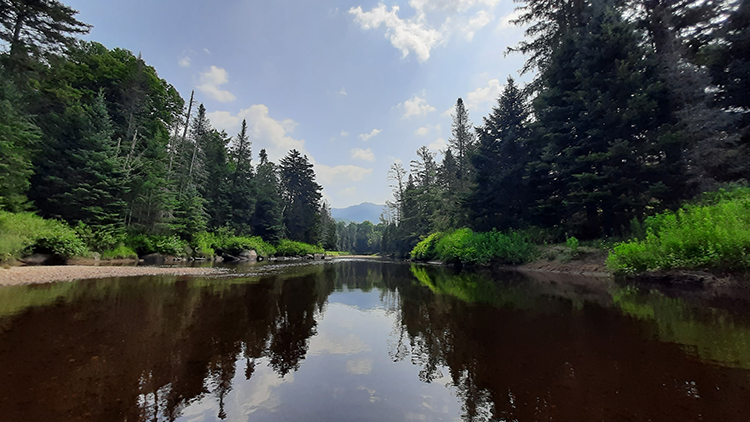
Migratory fish, amphibians, waterfowl, and other wildlife need for us to do better by our streams and ponds. New Yorkers should commence a systematic effort to remove deadbeat dams that block wildlife movement and to phase out “game” fish management in favor of native fish restoration. We also need to systematically survey culverts and bridges around the Park to assess how passable they are to fish, amphibians, and other wildlife. Trout Unlimited, The Nature Conservancy, and AuSable River Association are among groups conducting these assessments, then procuring funds to modify, remove, or replace culverts and bridges that block animal movement. With the triple crises of extinction and climate chaos and associated threats to human safety, we need to make our built environment – particularly roads, culverts, and bridges – more permeable to wildlife movement even as we retrofit them to be durable in the face of worsening storms.
Rewilding, as The Rewilding Institute historian John Miles has written, should happen at all scales, from local to global; and this applies to watery realms as much as to terrestrial ecosystems. Removal of big dams on major rivers is needed, but so is removal or notching or down-sizing of check dams and other small barriers on tributaries.
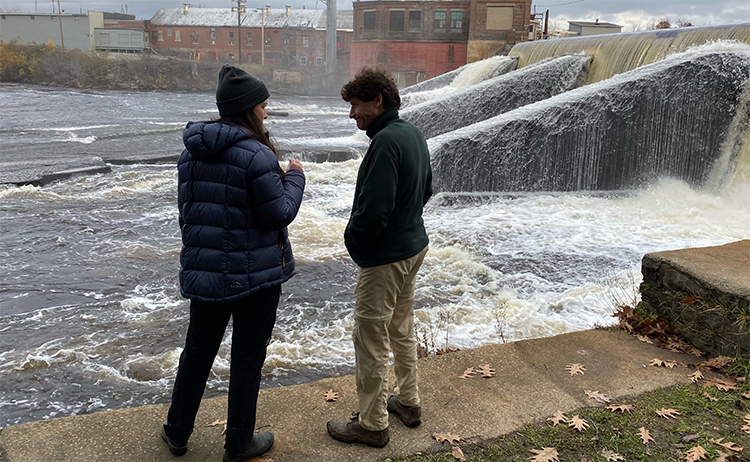
A case in point was made last year, by The Nature Conservancy (TNC) and others: A small check dam in Reber on a Boquet River tributary, Cold Brook, turned out to be a barrier blocking Landlocked Atlantic Salmon and Brook Trout from many miles of spawning habitat upstream. The barely noticeable dam (which I’d cycled past scores of times without noticing), however, gave Reber a reliable water pool in case of fire. This little dam, to me, epitomized our dilemma – the good folks of Reber needed to know the brave volunteer fire department has a water source, should misfortune strike and their house catch fire; but could some emergency pool be retained without denying our trout and salmon neighbors access to their historic birthing grounds? Fortunately, TNC, with help from US Fish & Wildlife Service and others, found a mutually beneficial solution in which another convenient source of emergency water was secured and the dam was successfully removed. Many miles of good native fish spawning habitat on Cold Brook has been reopened. Brook Trout will benefit from removal of the dam in Reber. The 2015 Eastern Brook Trout Joint Venture map confirms there are Brook Trout in Reber.
Dam removal need not disrupt human activities nor be terribly expensive. A hydro-power engineering friend of mine, Bob King, has urged that dam removals be done widely, simply, and inexpensively, rather than spending millions removing just a few.
Where to begin, then, is the question. Northern New York has hundreds of obsolete dams, most of which should be removed as soon as can be safely done. This is a public safety issue as well as a habitat connectivity issue. When old dams fail, homes or even lives can be lost. Adirondack Explorer rightly warned of this danger of old dams in a recent article series – then, sure enough, one of the dams they’d warned about, near Long Lake, failed in this summer’s torrential downpours and floods.
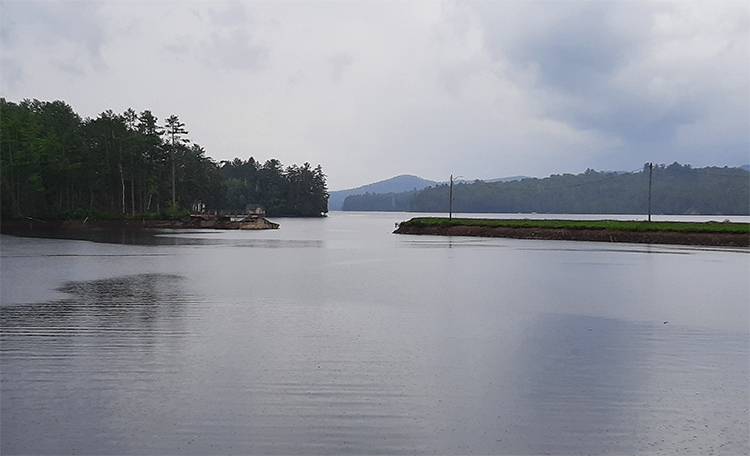
To the noble end of dam removal, helpful inventories have already been conducted. The New York Department of Environmental Conservation (NYDEC) has on-line a remarkably comprehensive inventory of dams across the state, and Cornell University has done a more detailed inventory of dams in the Hudson River watershed. Additional studies will no doubt be needed, but (as with wildlands network designs) much of the needed research has already been done, and more action should follow forthwith.
Often, it may make sense to start with dams lower on streams, since these may be obstacles past which diadromous fish and other migratory aquatic species cannot pass. On the Boquet River, for instance, salmon advocates successfully worked to remove the lowest dam, in Willsboro, and now are turning to obstacles higher on the river and its tributaries. Boquet River Association (BRASS) is reemerging as a leader in this work, having years ago accomplished the removal of a smaller dam on the North Branch of the Boquet near Lewis.
Placing high priority on dams known to be interfering with the movement of native species is likewise important. Among species we might help in northern New York through strategic removal of derelict dams are American Eel, American Shad, Brook Trout, Landlocked Atlantic Salmon, salamanders, and the various predators (humans included) of these mobile animals.
Remember, Adirondack Park has headwaters of Lake Champlain and the Hudson, Black, Mohawk, Raquette, Saranac, and other major rivers. So our diversity of fish species deserves major conservation attention.
Currently, the US House of Representatives is considering a bill introduced by New Hampshire representative Anne McLane-Kuster that would allot federal money to retrofit old dams that could again generate hydropower and remove others. This could be a big help not only for wildlife but for landowners, some of whom have old dams on their properties that are becoming liabilities and safety problems, as the obsolete structures deteriorate.
McLane-Kuster’s bill, the Twenty-First Century Dams Act, offers a good general approach: 1) Avoid any additional large man-made dams on natural streams. 2) Inventory existing dams. 3) Remove or let molder old obsolete dams. 4) Carefully retrofit for safe fish passage those dams deemed essential to human welfare, as for hydropower or irrigation.
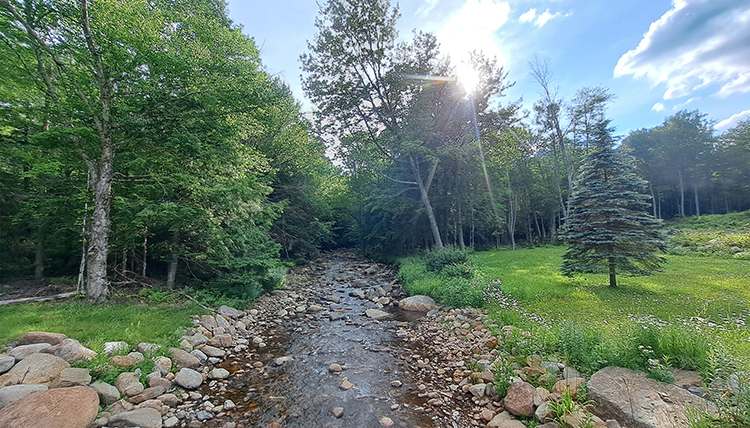
Our preliminary inquiries suggest that high priorities for dam removal in rivers draining the Adirondacks include the deteriorating dam on Spruce Mill Brook – another Boquet River tributary – in Lewis; the lowest few dams on the Saranac River; and obsolete dams in the Oswegatchie River watershed. We also believe priority should be placed on obsolete man-made structures blocking wildlife movement in the waterways of the Forest Preserve. We shall work with wild waterway partners to survey these obstructions and then work with the NYS Department of Environmental Conservation to get them removed or modified in coming years—so that our remote waters, as well as lands, can be Forever Wild too.
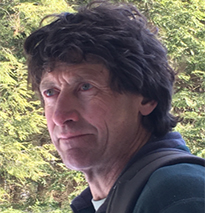
John returned to the Adirondack Council staff in 2021. He is now the Rewilding Advocate for the Council and also the Director of The Rewilding Institute. In these complementary positions, he promotes the protection and restoration of wilderness and wildlife throughout Adirondack Park and beyond. In recent years, John has also worked as a land steward with Adirondack Land Trust, Eddy Foundation, and Northeast Wilderness Trust, especially in Split Rock Wildway – a wildlife corridor linking Lake Champlain with the High Peaks. John often explores wild places, by hiking, paddling, and cross-country skiing. His long conservation treks are described in his book Big, Wild, and Connected: Scouting an Eastern Wildway from Florida to Quebec and in the TrekWest film Born to Rewild. John lives with his wife Denise Wilson-Davis in Essex, NY..




